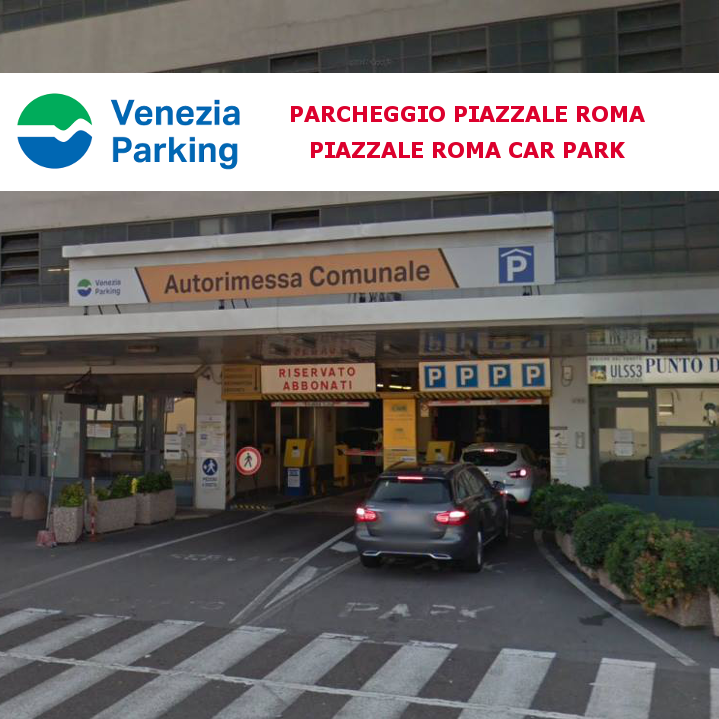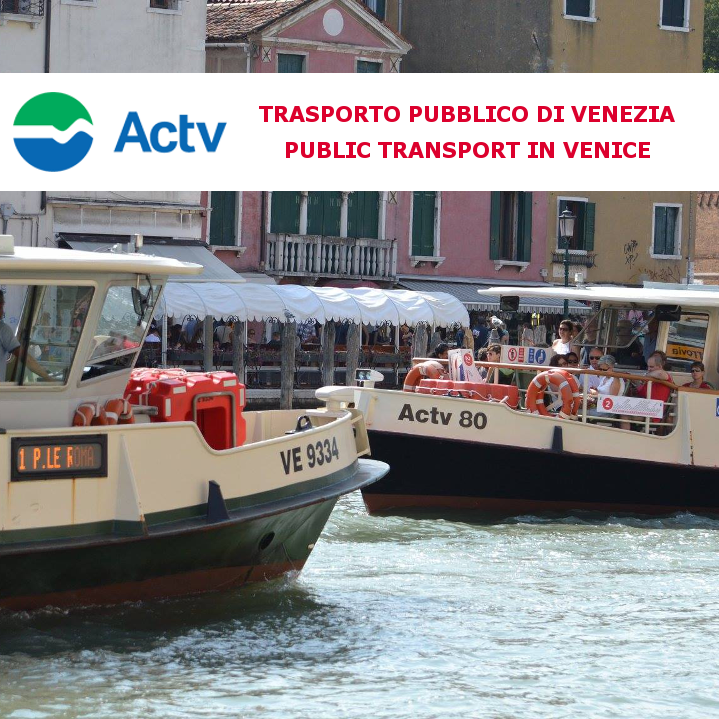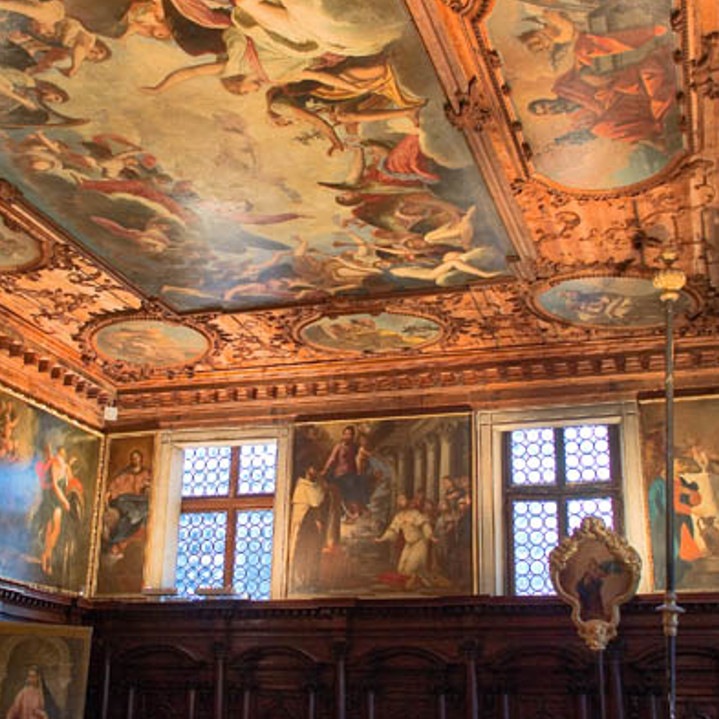You are here
Naval art, crafts and popular traditions: Venice's Castello district
Naval art, crafts and popular traditions: Venice's Castello district
This itinerary allows you to really get the feel of the Castello district, the largest sestiere in the city. It passes through the islands of San Pietro and Sant’Elena, discovering evocative places such as the Arsenale and symbols of the city’s multiculturalism, such as the Scuola Dalmata (Dalmatian School) and San Giorgio dei Greci Greek orthodox church, as well as gardens where you can take a break. The origin of the name Castello derives from the fact that there was once a fortified castle on the island of San Pietro di Castello; the stronghold dated back to Roman times and was used for defensive purposes in the event of attacks via the sea.
The itinerary takes about five and a half hours, which covers walking time and entry to the various churches that can be visited. If you wish, you can also add a visit to a museum or exhibition of your choice from those suggested. You can start the itinerary at any stage along the route, so it can vary in duration and distance to suit your requirements.
- Duration: 5–5.5 hours + 1 hour visit to a museum or exhibition of your choice
- Distance: 12 km
- Mode: On foot and/or by vaporetto
- Suggested period: All year round
- Suitable for children: Yes
- Disabled access: Partial
- Departure: Riva degli Schiavoni – Castello district
- Arrival: Island of Sant’Elena – Castello district
- Districts: Castello
- Links with other itineraries: “Monumental churches, synagogues and scuole grandi: a multicultural walk in Cannaregio”. Link from the basilica of Santi Giovanni e Paolo or church of Santa Maria Formosa
Itinerary details
- Departure: Riva degli Schiavoni – Church of San Zaccaria
- Stage 1: Church of San Zaccaria – A traditional oar maker's workshop
- Stage 2: A traditional oar maker's workshop – Campo Santa Maria Formosa - Palazzo Tetta
- Stage 3: Palazzo Tetta - Basilica of Santi Giovanni e Paolo - Scuola Grande di San Marco
- Stage 4: Basilica of Santi Giovanni e Paolo - Complesso dell'Ospedaletto - Barbaria de le Tole
- Stage 5: Barbaria de le Tole - Church of San Francesco della Vigna
- Stage 6: Church of San Francesco della Vigna - Arsenale Nord Tesa 105
- Stage 7: Arsenale Tesa Nord 105 - Pietra della Peste - Scuola Dalmata
- Stage 8: Scuola Dalmata - Church of San Giorgio dei Greci - Bragora
- Stage 9: Bragora - Monumental entrance of the Arsenale
- Stage 10: Arsenale - Island of San Pietro - Basilica of San Pietro di Castello
- Arrival: Basilica of San Pietro di Castello - Church of Sant'Elena
-
Sources
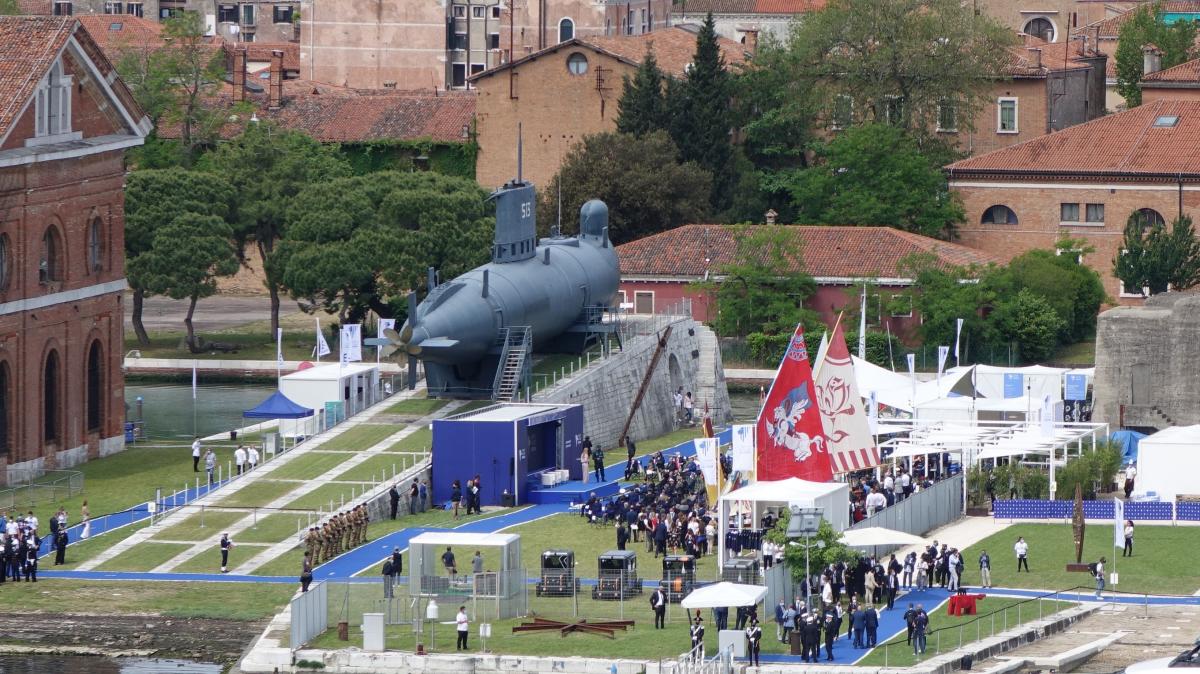
The Arsenale captured from the Porta Nuova tower with the Enrico Dandolo submarine
Departure: Riva degli Schiavoni – Church of San Zaccaria
The itinerary suggested begins or ends at the Church of San Zaccaria, depending on which direction you take, bearing in mind that you can start it at any stage.
The church, situated in the Castello district, is located near Riva degli Schiavoni, easily accessible on foot from any point of the city: ten minutes on foot from San Marco or by vaporetto with the following lines that stop at San Marco – San Zaccaria:
- Landing stage A: line 14
- Landing stage B: line 2; 20
- Landing stage B1: line 4.1: 7; N
- Landing stage C: Line 1; N
- Landing stage D: line 1; 5.1; 14; N
- Landing stage G: line 4.2; 5.2
Riva degli Schiavoni is a promenade of about 500 metres long, which skirts the basin of San Marco and extends towards the Castello district. It was a favoured entry point for those coming from the sea. Thanks to its proximity to San Marco, it was also a busy commercial area and the seat of various charitable confraternities. It owes its name to the Dalmatians, a population of sailors, merchants and men of culture who docked their ships along the bank. During the Venetian Republic, Dalmatia was known as Slavonia or Schiavonia, hence the name Riva degli Schiavoni.
From Riva degli Schiavoni, make your way into the Sotoportego di San Zaccaria, which will take you to Campo San Zaccaria, where the imposing monastic church of San Zaccaria is located.
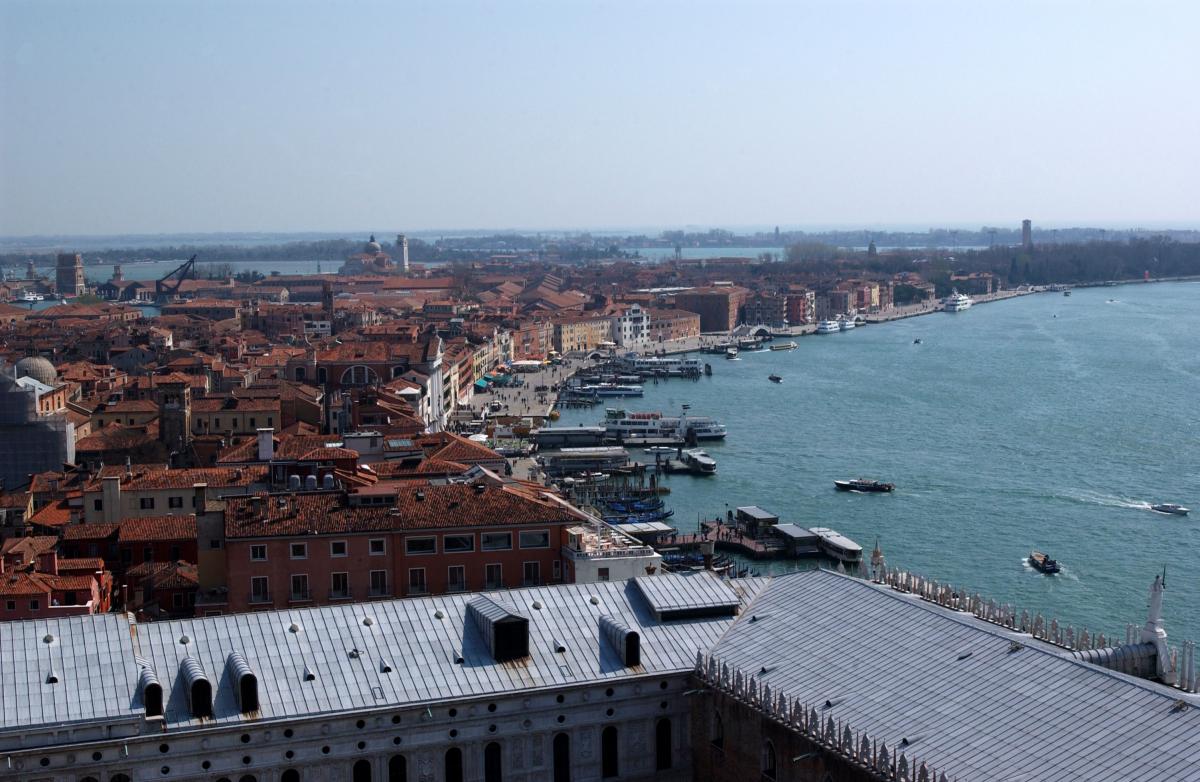
Riva degli Schiavoni seen from the bell tower of San Marco
Stage 1: Church of San Zaccaria – A traditional oar maker's workshop
The monastic church of San Zaccaria, dating back to the ninth century and subsequently modified in the tenth–eleventh century (surviving features from this time include the crypt, which corresponds to the central apse of the original church, the mosaic floor with animals near the altar, and traces of frescoes); it underwent major reworking in the fifteenth century and was given its current configuration by Mauro Codussi between 1480 and 1500. Codussi completed the work started by Gambello, giving the church its monumental appearance.
The interior is divided into three aisles. Along the right-hand aisle is an altar where the urn containing the remains of St Zacharias, father of St John the Evangelist, is kept, while the left-hand aisle houses the altarpiece of the Holy Conversion, painted in 1505 by Giovanni Bellini.
The chapel of Sant’Atanasio (also known as the choir chapel), features a series of paintings on all the walls, including the canvas of the Birth of St John the Baptist by Jacopo Tintoretto. The chapel of San Tarasio (also known as the golden chapel) preserves a beautiful altar with three Gothic polyptychs. At the base of the altar, the remains of the mosaic from the twelfth-century Romanesque/Byzantine apse can still be seen, while the hatch next to it contains a fragment of mosaic flooring dating back to the original ninth-century layout of the church. The pathway ultimately leads to the underground crypt, made even more evocative by the presence of water.
To continue the itinerary, cross the square, take Salizada San Provolo (follow the signs for Ospedale Santi Giovanni e Paolo) and turn right into Campo San Provolo. Go straight on to the beginning of Fondamenta de l’Osmarin and cross the Ponte dei Carmini. Following the street, before entering Sotoportego Rota, at no. 4725 on the left you will find a traditional oar maker's workshop, one of the remèri (oar makers) in the city, a manufacturer of rowlocks and oars.
Useful information:
- Church of San Zaccaria: open every day 10.00 a.m. – 6.00 p.m. No entry to visitors during religious services. Entrance to the chapels €3.
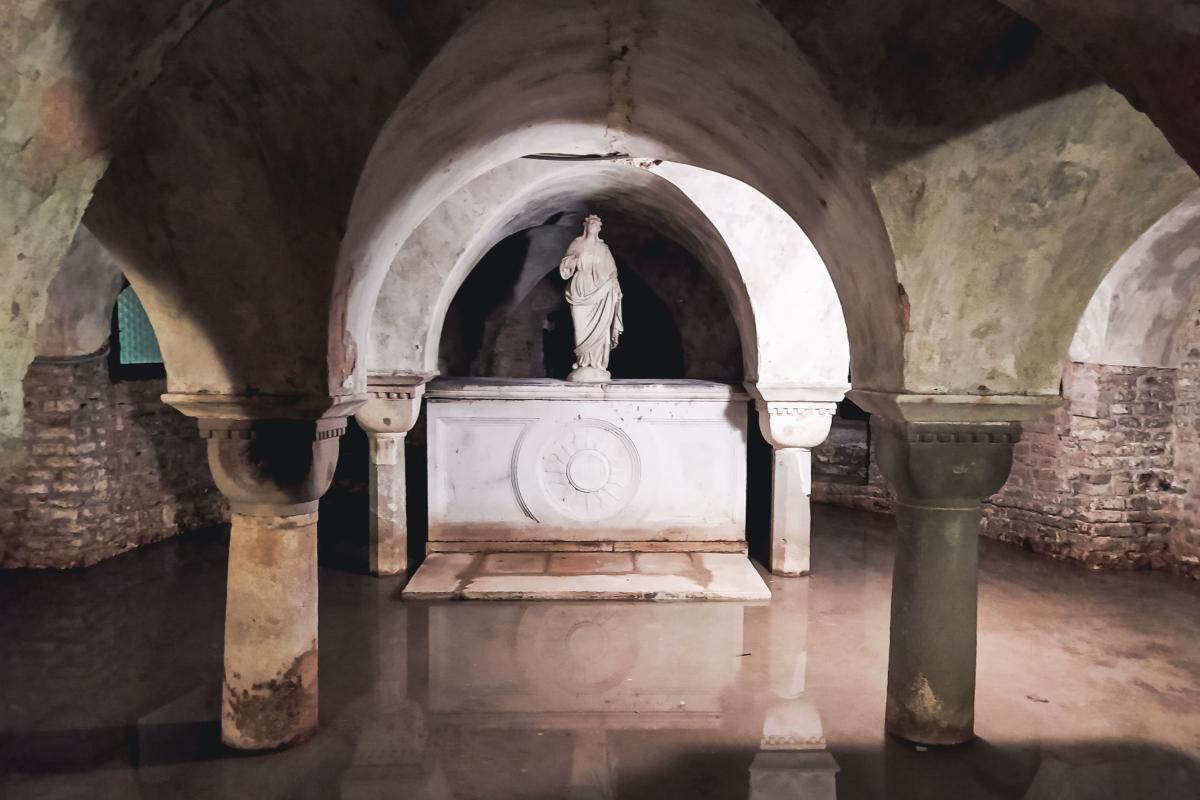
The crypt at the Church of San Zaccaria, made evocative by the presence of water
Stage 2: A traditional oar maker's workshop – Campo Santa Maria Formosa - Palazzo Tetta
The next stop is Santa Maria Formosa: make your way through the Sotoportego Rota, and continue along Calle Rota (there is a gate along the street on the right through which you can admire Corte Rota, a characteristic Venetian courtyard closed to the public); at the end of the street, turn right into Calle de la Corona and then take an immediate left into Ruga Giuffa, which will take you directly to Campo Santa Maria Formosa where you can join the “A walk through the Campi and Calli: from Cannaregio to San Marco through the Jewish Ghetto” itinerary.
At the end of Ruga Giuffa (the name possibly derives from Julfa, an Armenian city, in memory of the Armenians who once lived in this street), before crossing the bridge of the same name, you will see Museo Palazzo Grimani on the right in Ramo Grimani. This is the ancient home of the Grimani, one of the city’s most famous patrician families, which produced three Venetian doges. The palace was purchased by the state in 1981 and reopened to the public as a museum after a long period of renovation in 2008. It is famous today for its frescoes, stucco work and fine marble, as well as its collection of over one hundred and thirty antique sculptures in the Tribuna Grimani.
After crossing the Ponte Ruga Giuffa, you will come to Campo Santa Maria Formosa, the religious and civic centre of the city and the meeting point of three districts: Cannaregio, San Marco and Castello, of which the square is part. It was formerly one of the liveliest places in the city, hosting popular festivals (including the bull hunt), as well as home to the scuole of some of the most important commercial and craft guilds. The square is overlooked by numerous buildings of architectural merit dating back to different eras: Palazzo Ruzzini, the three Palazzi Donà, Palazzo Vitturi and Palazzo Malipiero.
In the centre of the square is the Church of Santa Maria Formosa, built at the behest of St Magnus, bishop of Oderzo, in 639, to whom the shapely Virgin is said to have appeared.
The current building, erected in 1492, is a masterpiece by Mauro Codussi, thanks to which the architect introduced the sculptural and spatial vision of the Tuscan Renaissance in Venice for the first time. The plan, in the shape of a Latin cross with three aisles, is aligned with the foundations of the seventh-century church. Indeed, the ninth-century renovation, during which the church was provided with a dome and a Greek cross plan, is still partly visible.
The result is a well-structured space, strongly characterised by the attractive central focus of the church, in which the clear light combines with the dense fretwork of the load-bearing walls, making the complex vaulted and domed ceiling seem to float.
Different styles were chosen for the two external facades, both commissioned by the Cappello family: the one facing the water, dated 1542, is reminiscent of classical style, while the other facing the square, dated 1604, is Baroque.
The artworks include: in the chapel of the Scuola dei Bombardieri, the Polyptych of St Barbara by Jacopo Palma the Elder (1480–1510), a work that made the artist’s name; the Last Supper by Leandro Bassano (late sixteenth century); in the chapel of the Concezione, the famous Triptych of the Madonna della Misericordia, in the style of Mantegna, by Bartolomeo Vivarini of Murano (1473).
The oratory houses a Madonna and Child with St Dominic by Giambattista Tiepolo (eighteenth century).
Interesting facts: Baldassare Galuppi worked as an organist in the church in 1722. The ancient organ was destroyed by an Austrian bomb during the First World War, in 1916.
A monstrous grotesque head was placed at the keystone of the entrance door to the bell tower, because it was believed to ward off the devil, who enjoyed ringing the bells.
The dome you can see today was rebuilt twice: the first time in 1668 after an earthquake, the second time in 1921 after a bombing raid in 1916, which partially destroyed the church and a number of paintings. The church was also the seat of several religious and professional schools, including the Scuola dei Casselleri, i.e. the makers of chests not only for transporting goods, but also for wedding trousseaus.
The last recommended detour, skirting the left-hand side of the church from Santa Maria Formosa, is the Campiello Querini Stampalia, where, on the other side of the canal, you can admire Palazzo Querini Stampalia, built in 1528. Since 1869, the building has been the seat of the Fondazione Querini Stampalia and was bequeathed to the city of Venice by Count Giovanni, the family’s last heir. Today it houses: the library, open until late at night on public holidays, the home-museum and a temporary exhibition space. It contains numerous paintings, including Giovanni Bellini’s Presentation at the Temple and a collection of paintings by Pietro Longhi and Gabriel Bella, whose canvases depict episodes from eighteenth-century Venetian life. The foundation’s garden is named after Carlo Scarpa, the architect who redesigned it in the early 1960s. It features references to Moorish and Japanese styles and to the traditions of the lagoon, such as a well, a Gothic lion and capitals.
To continue the itinerary in the direction of Palazzo Tetta, return to the centre of the campo (in front of the main entrance to the church) and turn into Calle Lunga Santa Maria Formosa, where you will find numerous craft shops selling pottery, jewellery, papier-mâché masks, glassware and textiles. Go down the street and turn left into Calle Bragadin or Calle del Pinelli, then walk onto the Ponte dei Conzafelzi, which looks onto the beautiful Palazzo Tetta on the right, the only building in Venice that looks onto canals on three sides.
Useful information:
- Church of Santa Maria Formosa: Monday to Saturday 11.30 a.m. – 1.30 p.m. and 2.30 p.m. – 5.00 p.m. www.chorusvenezia.org/chiesa-di-santa-maria-formosa
- Museo Fondazione Querini Stampalia: Tuesday to Sunday 10.00 a.m. – 6.00 p.m. Closed on Mondays. Full-price ticket €14. http://www.querinistampalia.org/ita/home_page.php
- Museo di Palazzo Grimani: Tuesday to Sunday 10.00 a.m. – 6.00 p.m. Closed on Mondays. Full-price ticket €15. https://polomusealeveneto.beniculturali.it/musei/museo-di-palazzo-grimani
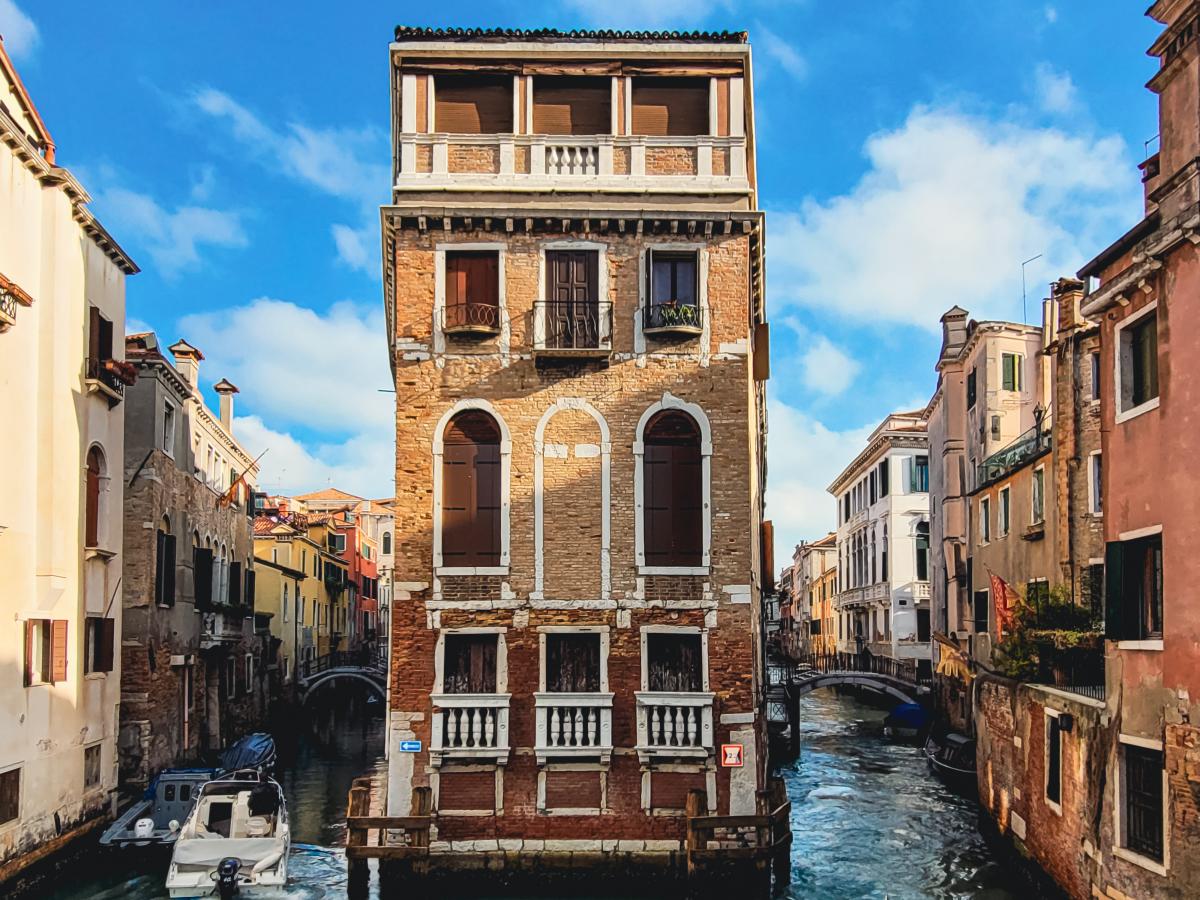
Palazzo Tetta, the only building in Venice with three sides looking onto a canal
Stage 3: Palazzo Tetta - Basilica of Santi Giovanni e Paolo - Scuola Grande di San Marco
To continue, cross the Ponte dei Conzafelzi and take Fondamenta dei Felzi on the left, turn into Calle Bressana and you will arrive directly in the heart of Campo Santi Giovanni e Paolo, one of the largest and most significant spaces in the city, home to important civic and religious buildings.
Campo Santi Giovanni e Paolo is one of the largest and most significant spaces in the city, home to important civic and religious buildings. The square was originally a marshy area, donated by the Republic of Venice to the Dominican friars, who reclaimed it in 1234, creating a large, well-defined urban space. At the centre of the square stands the bronze equestrian monument of Bartolomeo Colleoni, by Andrea Verrocchio, dating to 1481–1488, while nearby there is a lovely well decorated with high-relief festoons and putti, installed here in 1824. The Basilica of Santi Giovanni e Paolo, in the background, is one of the city’s finest examples of Gothic architecture and the place where the doges’ funerals were celebrated. The basilica is considered the “Pantheon of the Doges” because of the numerous funerary monuments of doges and other illustrious figures from the city housed there. It also contains works by artists of the calibre of Giovanni Bellini, Lorenzo Lotto, Giovan Battista Piazzetta, Pietro and Tullio Lombardo, and Bartolomeo Vivarini, as well as four canvases by Veronese.
To the left of the church facade you will see the Scuola Grande di San Marco, founded as the Scuola dei Battuti, the most imposing of the scuole grandi in Venice. Dating back to 1260, it became so influential that it took the name of the city’s patron saint. Inside, there is a vast hall on the ground floor, with its beamed ceiling supported by a succession of columns. The upper floor consists of the Sala di Capitolo (chapterhouse) and the Sala d’Albergo, which contain numerous paintings by Tintoretto and Giovanni and Gentile Bellini. Observing the ceiling of the chapterhouse, you will notice a number of coats of arms and symbols: in the centre a nimbed lion, the only one in the whole of Venice; the initials SMV indicating Santa Maria Valverde, the current Scuola della Misericordia; the eagle of the Scuola Grande di San Giovanni Evangelista; the initials SR indicating the Scuola Grande di San Rocco, and two circles symbolising the Scuola Grande della Carità, the current Accademia di Belle Arti (Academy of Fine Arts).
In 1485, a disastrous fire destroyed it entirely and the reconstruction was entrusted to the architect Pietro Lombardo, later replaced by Mauro Codussi, while the sculptural cladding of the facade was commissioned to Gentile and Giovanni Bellini. An interesting fact: the medical library in the chapterhouse has very ancient origins and contains almost 18,000 volumes, with writings by Hippocrates, Pliny, Falloppio and Ludovico Ariosto. Today the scuola is the entrance to the hospital and has been open to the public again since 2013. You might like to take a rest in this square, which has some benches and a little fountain behind the apse of the basilica (in Calle Luigi Torelli, also known as Calle de la Cavallerizza). It is also worth noting that, should you so wish, you can join the following itinerary at this point: “Monumental churches, synagogues and scuole grandi: a multicultural walk in Cannaregio”.
Useful informtion:
- Scuola Grande di San Marco: Tuesday to Saturday 9.30 a.m. – 5.30 p.m. https://www.scuolagrandesanmarco.it/
- Basilica of Santi Giovanni e Paolo: Monday to Saturday 9.00 a.m. – 6.00 p.m.; Sunday 12.00 noon – 6.00 p.m. Full-price ticket €3.50. https://www.santigiovanniepaolo.it/
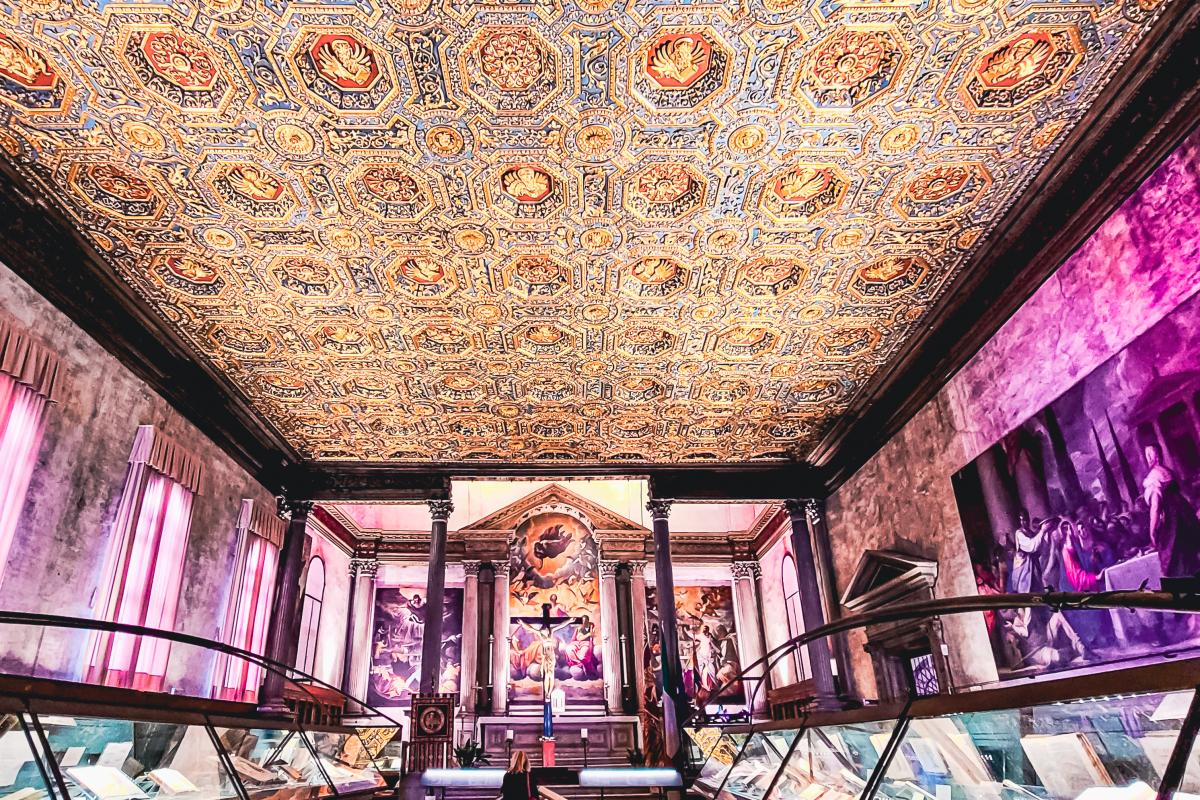
Scuola Grande di San Marco, the most imposing of Venice’s scuole grandi
Stage 4: Basilica of Santi Giovanni e Paolo - Complesso dell'Ospedaletto - Barbaria de le Tole
From Campo Santi Giovanni e Paolo, take Salizada San Zanipolo, which runs along the right-hand side of the basilica of Santi Giovanni e Paolo. Immediately on the left is the Complesso dell’Ospedaletto, which is composed of the Church of Santa Maria dei Derelitti, the Scala dei Sardi (Sardi Staircase), the Cortile delle Quattro Stagioni (Courtyard of the Four Seasons) and the Sala della Musica (Music Hall).
In the past, the “Ospedaletti” were institutions providing shelter for orphans, the destitute, widows and the elderly. This construction dates back to 1517. The construction of the church dedicated to Santa Maria dei Derelitti began in 1575, and Andrea Palladio is also linked to its design. Inside, among the altars created by Longhena, it houses important paintings from the seventeenth and early eighteenth centuries.
An interesting fact: the Complesso dell’Ospedaletto became famous for its choir of “putte”, namely young girls with wonderful singing skills, who rivalled the Coro della Pietà directed by Antonio Vivaldi.
The itinerary continues along Barbaria de le Tole, the street that runs straight on from the Complesso dell’Ospedaletto, and which is home to a number of craft shops. There is an interesting fact regarding the name of the street: this is where wooden boards used to be planed, removing the “barbs”, before they were used by the many carpentries that once looked across the northern part of the lagoon.
Useful information:
- Complesso dell'Ospedaletto: https://www.gioiellinascostidivenezia.it/i-gioielli/complesso-dell-ospedaletto/
The Sala della Musica (Music Hall) at the Complesso dell’Ospedaletto, where the “coro delle Putte” used to sing
Stage 5: Barbaria de le Tole - Church of San Francesco della Vigna
To reach the next stage, continue along Barbaria de le Tole and Calle del Cafetier until you reach Campiello de Santa Giustina detto de Barbaria. Here, turn right and take the first street on the left, Calle Zon, then cross the Ponte di Santa Giustina, which leads to the campo (square) of the same name. After the bridge, turn left onto the fondamenta (canal bank) where you will find the former convent of Santa Giustina, which now houses the Liceo Benedetti. Take the first street on the right, Calle San Francesco de la Vigna, and go straight on until you reach the square and the Church of San Francesco de la Vigna.
The name of the church derives from the extensive vineyards in the place where it stands. The vineyard, considered the largest in the city, was bequeathed in 1253, by the son of the Doge Pietro, to the Friars Minor. They erected a Gothic-style church on the site in 1300, together with a small Franciscan convent. Over the next two centuries, it was enlarged to the point of becoming one of the city’s largest convents. The present church was built for the Franciscan Order and is the work of Jacopo Sansovino, who began the work in 1534, and Andrea Palladio, who completed it in 1570, creating the facade, which is a rich composition of classical architectural elements.
The church houses some highly prestigious works, including pieces by Paolo Veronese and Giambattista Tiepolo, Tintoretto and Palma the Younger, as well as two bronze statues of Moses and St Paul by Titian. In the Giustiniani Chapel, to the left of the chancel, you can admire numerous sculptures by Pietro Lombardo and his school. The funerary works inside the Chapel, dedicated to the family, include the tombs of the Doges Francesco and Alvise Contarini and the funeral monument by Scamozzi. It is also worth noting that on show in the church are four photographic representations of some seventeenth-century paintings of the plague in Corte Nova (see stage 7 of the itinerary).
The bell tower stands out at the back of the building. It is similar to the bell tower of San Marco, and one of the tallest in Venice (approx. 70 metres high). It was built from 1543 onwards, over the foundations of an earlier Gothic tower.
From Campo San Francesco, there are various options for continuing the itinerary:
- continue to stage 6 and visit the Arsenale Nord on foot or by vaporetto;
- continue to stage 7 in the direction of Pietra della Peste (skipping stage 6);
- take the vaporetto towards the islands of San Pietro and Sant’Elena for stage 10, skipping stages 6-7-8-9. To catch the vaporetto at the Celestia stop, follow these directions: from Campo San Francesco, continue along Calle drio la Chiesa, Calle del Cimitero and Corte da Ponte, then make your way along Calle del Cimitero and take an immediate left into Calle Sagredo, which will lead you directly to the North Lagoon, where the Celestia vaporetto stop is located.
Useful information:
- Church of San Francesco de la Vigna: opening hours 8.00 a.m. – 12.30 p.m. and 3.00 p.m. – 7.00 p.m. https://www.isevenezia.it/it/chiesa-e-convento/storia-della-chiesa-e-del-convento-di-san-francesco-della-vigna
- Vaporetti: Celestia stop: lines 4.2 and 5.2 (direction of Bacini - Arsenale).

Vineyards at the convent of San Francesco della Vigna, among the largest in the city
Stage 6: Church of San Francesco della Vigna - Arsenale Nord Tesa 105
From Campo San Francesco della Vigna, we recommend stopping off to visit the Arsenale Nord, which will allow you to get to know another area of Venice steeped in history and tradition.
There are two different ways to access the Arsenale Nord through the public entrance located in Tesa 105: walk along an elevated walkway that skirts the North Lagoon, offering a beautiful view of the waterfront, or take a regular vaporetto from the Celestia stop to the Bacini - Arsenale Nord stop.
From Tesa 105, you can decide whether to continue with stages 7-8-9 of the proposed itinerary or to go directly to stage 10 by taking the vaporetto towards the island of San Pietro.
Here’s how to get to Tesa 105 or the vaporetto: from the right-hand side of the church in Campo San Francesco, continue along Calle drio la Chiesa, Calle del Cimitero and Corte da Ponte, keep going along Calle del Cimitero and then take an immediate left into Calle Sagredo, which will lead you directly to the Celestia area of the North Lagoon. From here, turn right into Fondamenta le Case Nove, where you can decide whether to continue on foot or by vaporetto.
To continue on foot, cross the bridge and walk along the entire elevated walkway that skirts the North Lagoon on the left and the Arsenale area on the right, until you get to Calle Giazzo. From here, continue straight on and follow the signs to the ground floor of Tesa 105, characterised by four distinct volumes that recall the “taccate”, supports used to raise hulls up so that they could be worked on in the shipyards.
Once you step out of Tesa 105, you will find yourself in front of the dock. This is a good spot to admire the entire expanse of this exceptional monumental complex, which occupies 48 hectares.
Leaving behind the Tesa della Novissima, the most recent part of the Arsenale, built in the early sixteenth century, you can admire the Dandolo submarine on the right and the art installation Building Bridges by Lorenzo Quinn on the left.
The Arsenale, built in the twelfth century, grew to such an extent that it was the world’s largest naval factory for centuries, building the fleets behind the Serenissima’s economic, political and commercial power. The buildings and production areas of the Arsenale complex maintained their original function until the beginning of the First World War, undergoing constant physical and functional adaptations as shipbuilding techniques evolved. The tese were sheds originally completely open on the short sides facing the dock, looking directly onto the water, and were used as covered slipways. The original layout also allowed complete transits from one shed to another. The current configuration of the tesa postdates the nineteenth-century reorganisation of the Arsenale by General Martini and the consequent transformation of the yards into warehouses and stores.
All the surrounding urban space developed around this site, characterising the Castello district as the home of workers at the Arsenale, called arsenalotti, and the site of shipbuilding services in all their many forms. Evidence of this can be found in the place names: Calle del Piombo (lead street), Calle delle Ancore (anchor street), Calle della Pegola (pitch street) and Calle delle Vele (sail street).
During the first twenty years of the twentieth century, the impossibility of adapting the spaces of the Arsenale to the needs of the emerging industry meant that it was no longer feasible to keep production here, and it was transferred to the mainland. The Italian Navy remained at the Arsenale, continuing to carry out some of its activities here. The shipbuilding plants were progressively dismantled, and the Arsenale as a whole experienced a period of abandonment and progressive decline.
The use of the Corderie dell’Arsenale, granted during the first Venice Biennale Architecture Exhibition in 1980, represents the first important step in the conversion of the former factory. Starting in 2002, significant safety, restoration and consolidation work was carried out on the roof structures. In 2012, following an international call for ideas, Tesa 105 underwent redevelopment and transformation work. Since February 2013, the Municipality of Venice has owned almost two thirds of the complex, effectively taking on the role of main promoter of the Arsenale. Since 2019, the Arsenale has hosted the Venice Boat Show, an international exhibition of Italian and international nautical excellence.
The vast area of the Arsenale is divided up as follows:
- Arsenale Nord: the public spaces and the ground floor of Tesa 105 are open to the public (where you are now);
- Arsenale Sud: the spaces are used by the Fondazione la Biennale di Venezia and are only accessible, to ticket holders, when the exhibitions are open (May–November);
- Area owned by the Navy: not open to the public. Contact the Istituto di Studi Militari Marittimi regarding visits.
In addition, the Arsenale, the heart of Venetian naval power, has been the setting for many films, one of the most recent being The Tourist (2010), starring Johnny Depp and Angelina Jolie.
Useful information:
- Tesa 105: Monday to Friday 8.00 a.m. – 3.00 p.m. https://www.comune.venezia.it/it/content/visitare-larsenale
- Istituto di Studi Militari marittimi https://www.difesa.it/Protocollo/AOO_Difesa/Marina/Pagine/MSTUDI.aspx
-
Vaporetti:
• Celestia stop: lines 4.2 and 5.2. (Bacini – Arsenale direction)
• Bacini - Arsenale Nord stop: lines 4.1 and 5.1 (Celestia direction); lines 4.2 and 5.2 (San Pietro di Castello direction).
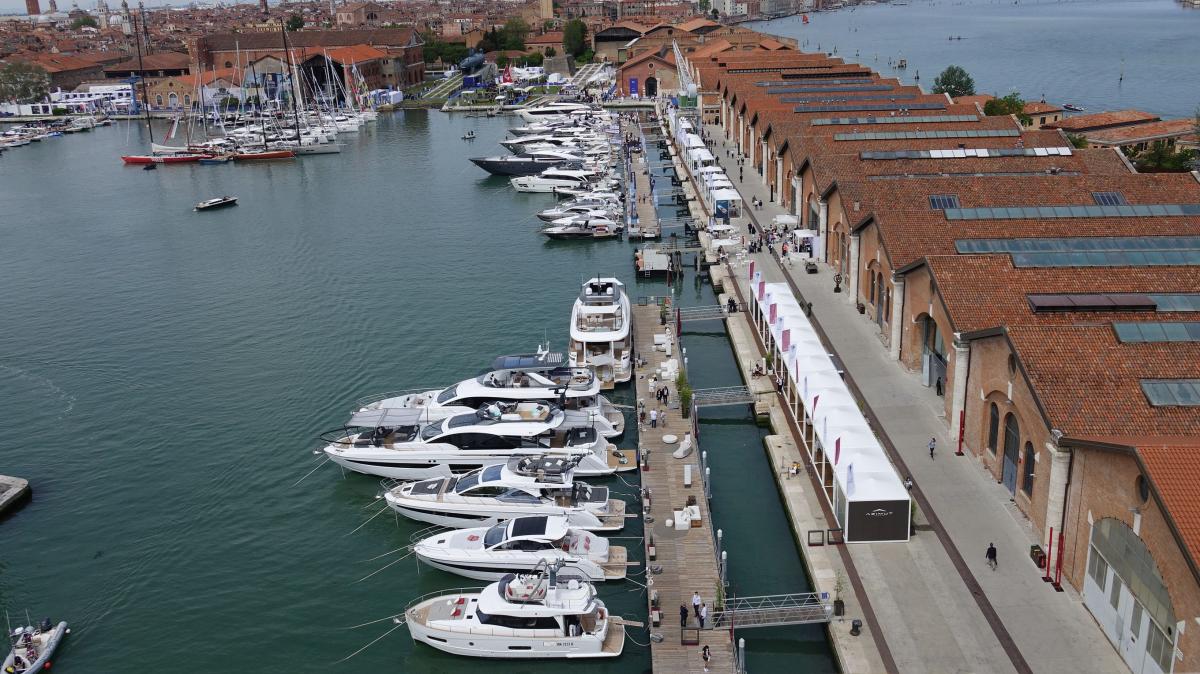
The Arsenale captured from the Porta Nuova tower
Stage 7: Arsenale Nord Tesa 105 - Pietra della Peste - Scuola Dalmata
There are two different ways to get back to Campo San Francesco from Tesa 105: continue on foot along Calle Giazzo and the elevated walkway until you reach Fondamenta de le Case Nuove, or take the vaporetto at the Bacini - Arsenale stop in the direction of Celestia. From the Celestia stop located in Fondamenta de le Case Nuove, take Calle Sagredo on the left, then turn right onto Calle del Cimitero and continue on through Corte da Ponte, Calle del Cimitero and Calle drio la Chiesa.
Once you have reached Campo San Francesco della Vigna, go past the raised sottoportico and make your way to Campo de la Chiesa, cross the Ponte di San Francesco and follow Ramo al Ponte San Francesco, then turn right into Salizada Santa Giustina. In this salizada, on the right, you can see Palazzo Contarini della Porta di Ferro, so called because the door was once covered with iron studs.
From Salizada Santa Giustina, turn left into Calle Zorzi, which will take you directly to Corte Nova. The Sotoportego de Corte Nova contains the Pietra della Peste (Plague Stone), the only red stone in Venice, which symbolises the defeat of the plague. You should not step on the stone, as doing so is said to bring bad luck. Its history dates back to around 1630, when the plague killed almost 80,000 Venetians, and the Corte Nova area was the only part of Venice to be spared.
Popular tradition has it that one day the Virgin Mary appeared to a local woman named Giovanna and asked her to have a painting done in the sotoportego depicting the Virgin Mary with St Roch and St Sebastian: this would keep the plague away. The fact that Corte Nova was spared the plague is represented by: the red stone on the paving that shows the exact point where the plague stopped, the two altars dedicated to the Madonna, four photographic representations of seventeenth-century paintings depicting the event (the originals are on display in the Church of San Francesco della Vigna), and the inscription at the entrance to the sotoportego.
A few minutes from Corte Nova you will come to the Scuola Dalmata dei Santi Giorgio e Trifone: cross the Ponte de la Corte Nova, take an immediate left onto Fondamenta San Giorgio dei Schiavoni, which runs alongside Rio de Sant’Antonin, and cross the first bridge on your left, the Ponte de la Comenda. Here you will find the Scuola Dalmata di San Giorgio e Trifone, also known as the Scuola di San Giorgio degli Schiavoni, founded with the intention of bringing together citizens of Dalmatian origin living in Venice following the conquest of Dalmatia by the Venetians in 1451.
In 1806, following the fall of the Venetian Republic, Napoleon decreed the suppression of all Venetian scuole and convents and the acquisition of their assets, including works of art. However, the Scuola Dalmata was one of the few schools that managed to preserve its cultural heritage. It still houses one of the most extraordinary cycles of painting from the early Venetian Renaissance, painted by Vittore Carpaccio in the early sixteenth century and depicting the stories of George, Tryphon and Jerome, the three patron saints of the confraternity.
Useful information:
- Scuola Dalmata: opening hours 10.00 a.m. – 5.30 p.m. every day (closed on Tuesdays). See the website for ticket prices https://www.scuoladalmatavenezia.com/
- Vaporetto: Bacini - Arsenale Nord stop: lines 4.1 and 5.1 (direction of Celestia).
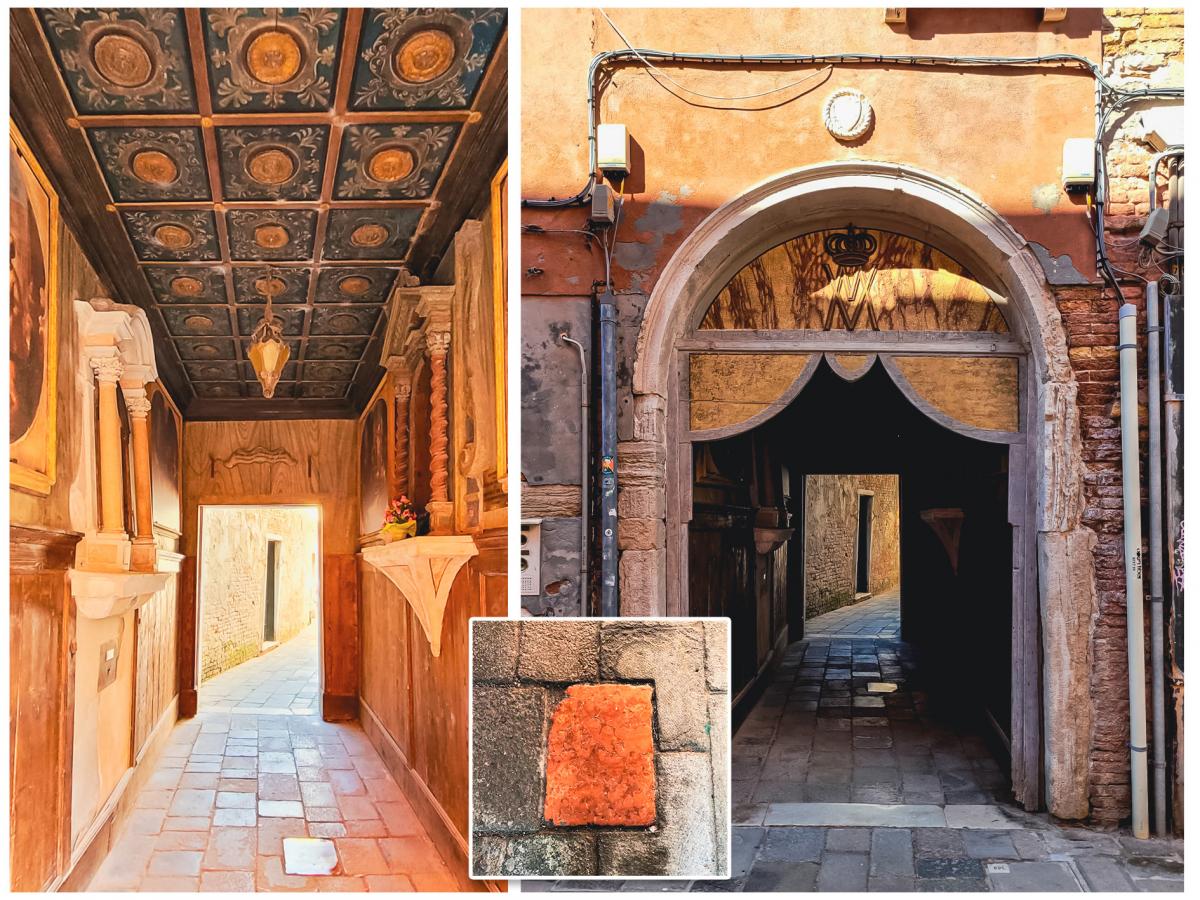
The “Pietra della Peste”, or Plague Stone, symbolising Venice’s victory over the seventeenth-century epidemic
Stage 8: Scuola Dalmata – Church of San Giorgio dei Greci - Bragora
Before reaching the monumental entrance to the Arsenale, one of the most symbolic places in the Serenissima, we suggest making another stop along the way. From the Scuola Dalmata, turn right onto Fondamenta dei Furlani, which runs along the canal, and follow it all the way to Campiello Sant’Antonin. Cross the Ponte Sant’Antonin on the right and continue straight on into Salizada dei Greci. At the end of the salizada, you will find Campiello de la Fraterna; continue along Calle de la Madonna and before the Ponte dei Greci on the left, you will see a small white marble fondamenta that leads to the Museo delle Icone Bizantine e Post-Bizantine (Museum of Byzantine and Post-Byzantine Icons) at the Istituto Ellenico (Hellenic Institute), which houses works created between the fourteenth and eighteenth centuries, and to the Church of San Giorgio dei Greci.
The history of the foundation of the Scuola dei Greci and the Church of San Giorgio goes back more than 500 years, to when the Venetian government approved the establishment of the charitable Confraternita dei Greci Ortodossi (Confraternity of Orthodox Greeks), or Scuola Greca, in 1498. Work on the church began in 1539, following a design by the architects Sante Lombardo and Giannantonio Chiona, and the building was consecrated in 1561. The dome was added later, in 1571, and was frescoed by Giovanni Ciprios. The church facade features three architectural tiers, enhanced by horizontal divisions. On either side of the central doorway are two windows that contrast with the corresponding aedicules placed in the central division of the facade. The church interior includes an iconostasis, an architectural element that characterises Greek Orthodox churches, which is made of marble and decorated with late Byzantine paintings with a gold background. Inside there are also works by the Cretan painter Michael Damaskinos, Byzantine paintings and icons, as well as the cenotaph of Archbishop Gabriel Severo, by Longhena. The churchyard in front of the church contains the bell tower built between 1587 and 1592, to which the belfry was added in 1617. The bell tower has developed a considerable tilt since the time of its construction. There is a small courtyard next to the church, with a late Gothic well in the middle dating to the late fifteenth century, with relief sculptures of St George and St Nicholas.
The Istituto Ellenico di Studi Bizantini e Post-Bizantini (Hellenic Institute of Byzantine and Post-Byzantine Studies), housed in the Collegio Flanghinis building, was founded in 1951 following an agreement between Italy and Greece, and is the only Hellenic research centre outside of Greece. In 1953, the Greek state donated the tangible and intangible assets of the Venetian Greek Orthodox Fraternity to the Istituto Ellenico.
From here, turn back, walk along Salizada dei Greci, cross the Ponte Sant’Antonin and continue to the right along Salizada Sant’Antonin, where you will find a number of craft workshops of antique dealers, glassmakers, mosaicists and tailors, for example. At the end of the salizada, turn right to reach Campo Bandiera e Moro or Campo de la Bragora, dedicated to the brothers Attilio and Emilio Bandiera and to Domenico Moro, Venetian patriots shot by the Bourbon troops in Calabria in 1844. In memory of the Bandiera brothers and Moro, a flagpole was erected in the centre of the square in 1866, next to the two fifteenth-century wells.
The square is also known as the Campo de la Bragora, due to the presence of the adjacent church of San Giovanni in “Bragora”: a term that can be traced back to the Greek word “agorà”, or square, intended not only as a physical place but also as an economic, political and social centre, because the square, which is quadrangular in shape, was the centre of one of the most substantial settlements in the city. We recommend visiting the Church of San Giovanni in Bragora, dedicated to St John the Baptist, founded in the early eighth century and later rebuilt in its current form between 1475 and 1505. The church has a brick facade with late Venetian Gothic forms and is divided into three aisles inside.
It houses countless artworks, including a late-fifteenth-century altarpiece by Cima da Conegliano depicting the Baptism of Jesus. You can exit the right-hand side aisle into Campiello del Piovan, which contains three wells, one of which has an unusual cubic shape and is for private use, as you can read in the inscription. The square is lined with trees and equipped with benches, as is Campo de la Bragora. A few steps from Campiello del Piovan, following Calle del Forno on the right at the end of the square, you can reach Riva degli Schiavoni.
An interesting fact: next to Palazzo Gritti-Badoer (the building on the corner of Campo Bandiera e Moro and Salizada Sant’Antonin), you will find Calle della Morte (death street): a small L-shaped street, which used to have one exit closed off. This was a place where some of the Republic’s most “inconvenient” characters – those who could not undergo trials, those responsible for political crimes, spies, etc. – used to disappear.
Useful information:
- Museo delle icone bizantine e post-bizantine http://istitutoellenico.org
- Church of San Giovanni in Bragora: Monday to Saturday 9.15 a.m. – 11.45 a.m. and 3.30 p.m. – 6.00 p.m.; Sundays and public holidays: 9.15 a.m. – 11.45 a.m. http://www.sgbattistainbragora.it/index.php
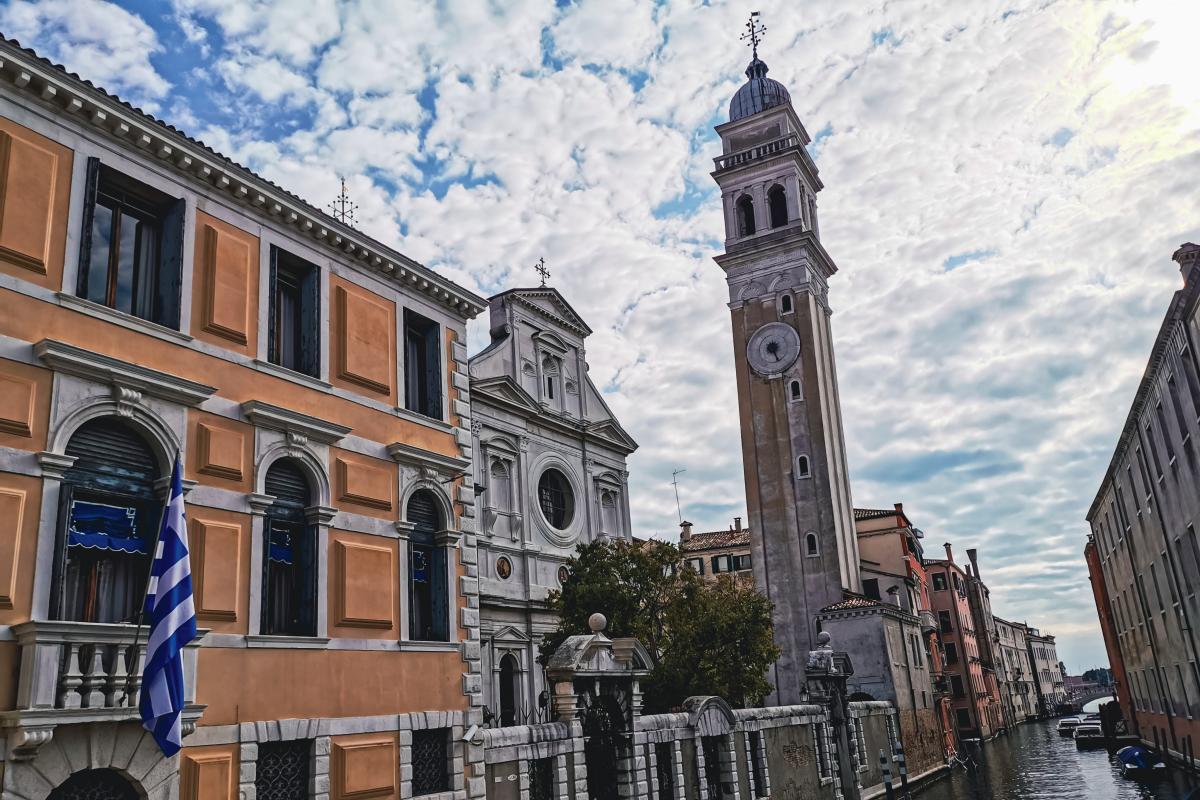
Church of San Giorgio dei Greci and the Museo delle Icone Bizantine at the Istituto Ellenico
Stage 9: Bragora - Monumental entrance to the Arsenale
To continue the itinerary, return to Salizada Sant’Antonin and go straight on to Salizada del Pignater. Here you will notice the very low Sotoportego dei Preti on the right. On the top of this porch is a stone heart, which is said to bring good luck to lovers. From Salizada del Pignater, follow the yellow signs for the Arsenale, turn right into the narrow Calle dei Corazzieri and then left into Calle dei Pestrin. Once you have reached the rio (minor canal), walk along a short stretch of Fondamenta Tintor and cross Ponte Storto, which leads to Campo San Martin, where you can see the church of San Martino, founded in the early seventh century and then rebuilt from the sixteenth century onwards to a design by Sansovino, who changed its orientation and basilica layout. The portal is by Sansovino and nearby there is a lion's mouth for denouncing blasphemers. The bell tower at the back is in Gothic style.
Next to the church, on the right-hand side, is the former Scuola di San Martino dell’arte dei Calafati (school of the pitch spreaders’ guild) and the Sovegno dei Musici. Above the door of the school is a fifteenth-century bas-relief of St Martin on horseback giving his cloak to the poor. St Martin of Tours was one of the most popular saints in Europe from the Middle Ages onwards. His funeral was held on 11 November 397 and this saint is venerated every year on that date. The Feast of St Martin is very keenly felt in the Venice area and very popular with children, who walk around the city banging lids and pots and singing songs. On this day, the local pastry shops and bakeries display the traditional cake of “San Martino”, which features St Martin on horseback. The church used to house some of the saint’s relics, including a piece of tunic, a phalanx and a tibia. The saint’s tibia was then given to the Scuola Grande di San Giovanni Evangelista, subject to the condition that on 11 November every year it would be carried in procession from the Scuola di San Giovanni to the Church of San Martino. This tradition died out after the end of the Venetian Republic.
Go straight on down Fondamenta de fronte l’Arsenal until you reach Campo de l’Arsenal, where the Arsenale area begins. Here, you will find yourself at the foot of the monumental “ground” entrance with its imposing portal, built between 1457 and 1460. It was modelled on ancient Roman triumphal arches and attributed to Antonio Gambello.
The side columns were recovered from the earlier medieval gate and feature eleventh-century Venetian-Byzantine capitals. Above the entablature is the winged lion of St Mark, the symbol of the city. Following the naval victory over the Turks at Lepanto in 1571, the gate became a memorial and the inscription on the frieze “Victoriae navalis monimentum MDLXXI”, the statue of St Justina, and the two winged statues of the Victories on the spandrels were added. Once he became doge, the Capitano Generale da Mar, Francesco Morosini, awarded the title of “Peloponnesiacus”, contributed to further enriching the entrance to the Arsenale, ordering the replacement of the wooden bridge with a closed terrace, surrounded by an iron gate spaced by eight pillars, each decorated with trophies in relief and topped with an allegorical statue.
On the right, next to the entrance, we can recognise Neptune, then Bellona, Vigilance and Abundance; on the left, Mars, then Justice and two other statues whose allegory is unknown.
During 1692, two colossal lions were placed on either side of the terrace: the crouching lion that adorned the Greek port of Piraeus and the reclining lion originally placed along the Lepsina road, which linked Athens to Eleusis. In 1694, the two large wooden doors that close the entrance were clad entirely in copper plate and embossed with trophies of arms, which also commemorated the deeds of the great leader and doge Francesco Morosini, whose family coat of arms was reproduced here.
A third Lion was placed here in 1716 by Francesco Nani Mocenigo, after his victorious resistance against the Turkish siege of the fortress of Corfu. This archaic Greek sculpture from the sixth century B.C. bears the following inscription on its base: “anno corcyrae / liberate”.
Lastly, the fourth lion, placed on the right-hand side of the entrance, is the smallest and oldest of all, installed here to commemorate the Venetian reconquest of Corfu (1717). It originally came from the Terrace of the Lions on the island of Delos in the Cyclades archipelago.
An interesting fact: the magnificence of the Venetian Arsenal is celebrated by Dante Alighieri, who mentions it his Divine Comedy, in Inferno Canto XXI, where he refers to it as “Arzanà”:
As in the arsenal of the Venetians,
all winter long a stew of sticky pitch
boils up to patch their sick and tattered ships
The vast area of the Arsenale is divided up as follows:
- Arsenale Nord: the public spaces and the ground floor of Tesa 105 are open to the public (for more information, consult stage 6 of the itinerary);
- Arsenale Sud: the spaces are used by Fondazione la Biennale di Venezia and are only accessible, to ticket-holders, when the exhibitions are open (May–November);
- Area owned by the Navy: not open to the public. Contact the Istituto di Studi Militari Marittimi regarding visits.
Near the Rio dell’Arsenale is the water entrance that connects the docks inside the Arsenale to the basin of San Marco. It is characterised by two towers dating back to 1686.
To continue the itinerary, cross the Ponte de l’Arsenal that takes you across to the opposite fondamenta, Fondamenta de l’Arsenal, home to the only two places that bear witness to the Arsenale’s original vocation (open to visitors for a fee): the Padiglione delle Navi (Ship Pavilion) and the Museo Storico Navale (Naval History Museum). To access the museum, walk the entire length of Fondamenta de l’Arsenal until you get to Campiello della Malvasia, where there are some benches. You will find the entrance to the museum on the left, in Campo San Biasio.
Useful information:
- Church of San Martino: Tuesday–Saturday 9.30 a.m. – 12.00 noon and 3.30 p.m. – 6.00 p.m.; Sunday: 9.30 a.m. – 12.00 noon (closed on Mondays). https://sanmartinovescovo.it/
- Arsenale: for more information, see https://www.comune.venezia.it/it/content/visitare-larsenale
- Museo Storico Navale: full-price ticket €10. See website for opening hours https://www.visitmuve.it/it/musei/museo-storico-navale-di-venezia/
- Padiglione dei Navi: for more information, see https://www.visitmuve.it/it/musei/museo-storico-navale-padiglione-delle-navi/
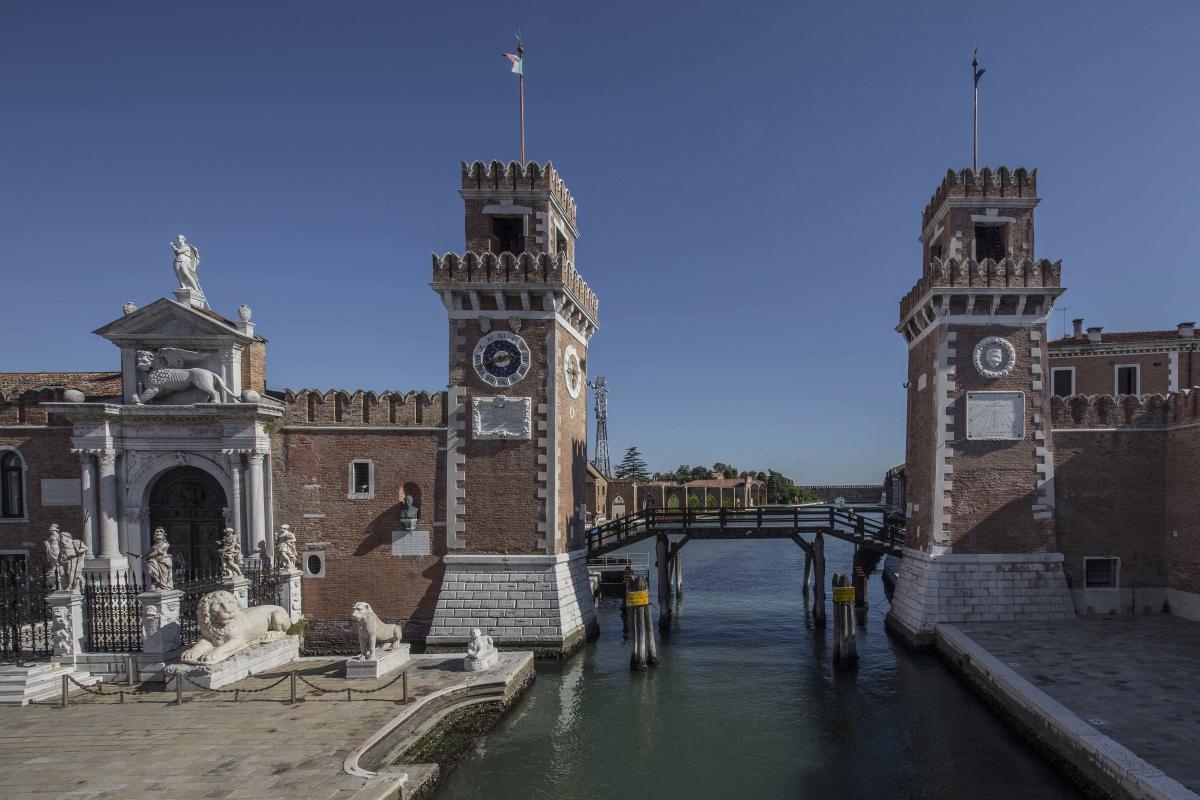
Monumental entrance to the Arsenale area
Stage 10: Arsenale - Island of San Pietro - Basilica of San Pietro di Castello
From Campo San Biasio, continue left into Riva San Biasio, cross the Ponte de la Veneta Marina and immediately after the bridge, turn left into Via Garibaldi, a wide street lined with taverns, restaurants and drinking fountains. Those who wish can stop at the Viale Garibaldi gardens. At the end of the wide street, keep right and take Fondamenta Sant’Anna, where the 2019 Spider-Man: Far from Home movie was filmed. Cross the second bridge you come to along the fondamenta, called the Ponte Sant’Anna, and continue straight along Calle Crosera, then Calle Ruga, until you reach Campo de Ruga. Here, go straight ahead into Salizada Streta, where you can choose to turn right into Calle larga de Castelo to get to the island of San Pietro or continue straight on to the Ponte dei Pensieri, which provides access to Giardino delle Vergini gardens (gardens accessible free of charge from May to November during the Biennale).
The Giardino delle Vergini is a large green space covering around 14,000 square metres, bordered by the walls of the Arsenale, where the former monastery of Santa Maria Vergine stood until the late nineteenth century. Following a challenging reclamation project implemented by the Biennale in 2000, the garden has become a scenic green space and also an exhibition space for artists and architects participating in the Biennale exhibitions. It offers a sweeping view over the Arsenale Nord, which includes the two hexagonal towers at the entrance to the Arsenale’s large dock, the Porta Nuova tower, the Bacini di Carenaggio wharf and the Novissima quay. The garden can be visited by following the Arsenale exhibition route, or directly via the Ponte dei Pensieri.
After this small detour, leave the Giardino delle Vergini behind, cross the Ponte dei Pensieri, turn into Calle larga de Castelo, cross the Ponte di San Piero and you will find yourself in Campo San Piero. This area represents three important elements in the history of Venice: the island of San Pietro di Castello was one of the first places where the Venetians settled; the lawn in front of the church is the only one left in Venice that has maintained its characteristic “campo” (field) appearance; the basilica was the patriarchal seat until 1807, when it was moved to the Basilica di San Marco. In the past, the island was known as Olivolo (according to some this was because of the olive trees that grew there, while others claim that it was because of its oval shape), before later becoming known as Castello due to the presence of the defensive structure. Castello is believed to be one of the first islands to be inhabited of those that initially formed part of the confederation from which Venice originated. It is also believed to have been the centre of the religious power of the city.
The basilica of San Pietro di Castello, dating back to the seventh century and originally dedicated to the Saints Sergius and Bacchus, was rebuilt on the basis of a model by Andrea Palladio and dedicated to St Peter at the behest of Bishop Magnus in the ninth century. The interior has a Latin cross plan, with three aisles, and is surmounted by a huge dome. The chancel is flanked by two side chapels, the Vendramin and Lando chapels, which respectively house The Madonna and Child with Souls in Purgatory by Luca Giordano and the All Saints mosaic altarpiece by Arminio Zuccato, based on a cartoon by Jacopo Tintoretto. Inside you can admire the Chair of St Peter of Antioch, which is said to have been used by the saint. The style evokes Muslim art, recognisable by the decorations with Arabic motifs and verses from the Koran.
The present bell tower, which stands detached on the right-hand side of the church, is a Renaissance work by Mauro Codussi, built between 1482 and 1490. Its uniqueness lies in its use of Istrian stone and its Renaissance forms.
Next to the church is Palazzo Patriarcale (Patriarchal Palace), which was used as a barracks after the cathedral was moved to San Marco.
An interesting fact regarding the basilica: since the ninth century, on 2 February each year – the day of the purification of Mary – the twelve most beautiful young women in the city, together with their spouses, received the nuptial blessing in the Church of San Pietro di Castello. Today, during the Festa delle Marie held in the Carnival period, a procession of twelve Venetian girls re-enacts the kidnapping and release of twelve betrothed brides by parading in Renaissance costumes from San Pietro di Castello to Piazza San Marco. The winner of the Festa delle Marie is then crowned Mary of the Year in Piazza San Marco by the Doge (a person playing the character of the doge) and will take the lead role in the “Volo dell’Angelo” (flight of the angel) the following year, when, attached to a rope, she will descend from the bell tower of San Marco to the centre of Piazza San Marco during the Carnival.
Useful information:
- Giardino delle Vergini: free entry; open to the public from May to November during the Biennale https://www.labiennale.org/it/luoghi/arsenale
- Church of San Pietro in Castello: Monday to Saturday 10.30 a.m. – 1.30 p.m. and 2.30 p.m. – 5.00 p.m. www.chorusvenezia.org/basilica-di-san-pietro-di-castello
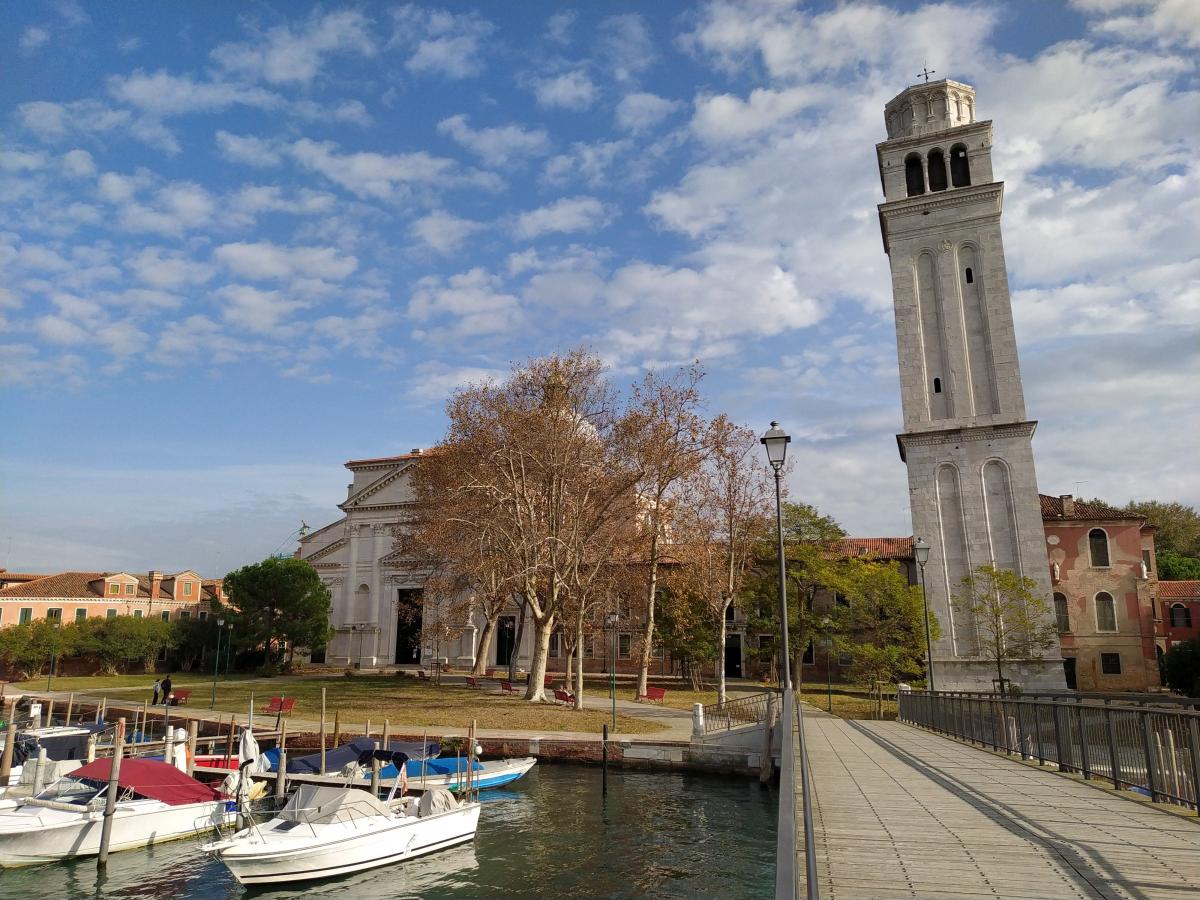
Basilica of San Pietro di Castello with its bell tower
Arrival: Basilica of San Pietro di Castello - Church of Sant'Elena
The last stop on this itinerary is the island of Sant'Elena, where you can enjoy a walk through the wide tree-lined spaces that border the lagoon, taking in a spectacular 180° view of the basin of San Marco, the island of San Giorgio Maggiore and the Lido.
From Campo San Piero, take the street to the right of the basilica that passes behind the bell tower, as suggested by its name Calle drio el Campaniel (street behind the bell tower, in Venetian dialect). Make your way to Fondamenta de Quintavale and turn right into Calle Quintavale, where you will come to the Ponte Quintavale that connects the island of San Pietro with Fondamenta Sant’Anna. The bridge offers an unmissable view from north to south, enhanced by the sounds of the movement of the water and the creaking of the boats. Go straight on, then turn left into Campiello Correra and follow Calle Gian Battista Tiepolo, which joins Corte del Magazen, until you reach the rio. From here, turn right into Fondamenta San Giuseppe and cross the first bridge you find on the left, the Ponte San Isepo. Now cross the square of the same name until Rio Terà Sant’Isepo, then turn left and follow this street until you reach Campiello del Paludo. Cross the Campiello on the right and then turn left into Calle Paludo Sant'Antonio, crossing the bridge of the same name at the end of the street and arriving on the island of Sant’Elena.
Go on along the tree-lined avenue, Viale IV Novembre, until you reach the “Parco delle Rimembranze” (Remembrance Park), dedicated to those who fell during the First World War. The park stands out for its towering maritime pines, hackberries, maples, cedars, holm oaks and elms, and is equipped with benches and play areas. At the end of this large avenue, turn left into Viale Piave and continue straight on along the river. Cross the first bridge, the Ponte di Sant'Elena, leaving the Pierluigi Penzo football stadium on your left, and continue straight ahead along the tree-lined Viale Sant’Elena, which will lead you straight to the Sant’Elena convent complex.
The Gothic-style church of Sant’Elena was founded in 1175 when the mortal remains of the saint were transported here from the East. Her remains are still kept in the chapel of the same name in the church. The building has a simple brick facade, in a conventual style, while the single-nave interior features a ceiling divided into bays, reinforced by wooden braces supported by barbacani (wooden beams typical of Venice).
There are two chapels inside: one is dedicated to the saint, with the Annunciation with donor by Marco Vecellio on the door; the other, the Giustiniani chapel, is used as a sacristy. Many paintings that once adorned the church are now in the Gallerie dell’Accademia, while the great altarpiece from the high altar is kept at the Pinacoteca di Brera in Milan. It is also worth noting that the characteristic cloister of Sant’Elena, adjacent to the church, is open to visitors.
Your walk ends here. We recommend heading back towards Parco delle Rimembranze in order to get to the public transport landing stages.
We would also like to mention two additional green spaces you will encounter on your way back towards Riva dei Sette Martiri: the Giardini di Viale Garibaldi, with the monument in honour of Garibaldi, built in 1885, and the Giardini della Marinaressa.
Useful information:
- Church of Sant’Elena: open every day 9.30 a.m. –12.00 noon and 3.00 p.m., – 5.00 p.m. http://www.parrocchie.it/venezia/santelena/
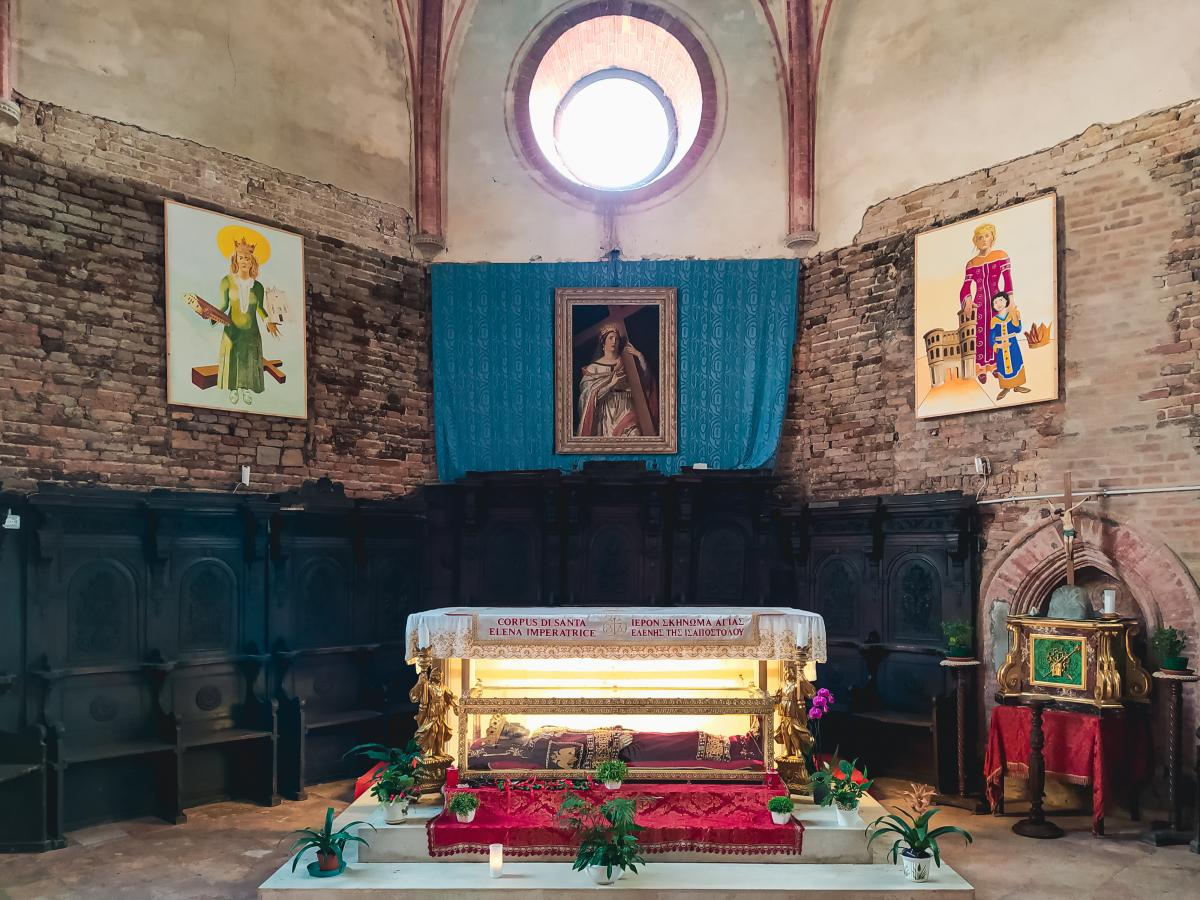
The mortal remains of the saint are housed in the Church of Sant’Elena
Sources
-
Guida Rossa Touring Club Italiano. 2005. Venezia. La biblioteca di Repubblica
-
Giulio Lorenzetti – Venezia e il suo estuario, 1974
-
1999. Calli, Campielli e Canali – Guida di Venezia e delle sue isole. Edizione Helvetia
-
Marina Crivellari Bizio. 2009. Campi Veneziani – Storia e segreti dei campi veneziani. Filippo Editore Venezia
-
Mariagrazia Dammicco. 2013. Guida ai Giardini Veneziani. La Toletta Edizioni.
-
Visite guidate e non in alcuni punti di interesse tra i quali chiese, musei, mostre e botteghe di artigianato etc.
-
Consultazione dei siti ufficiali dei principali punti di interesse



